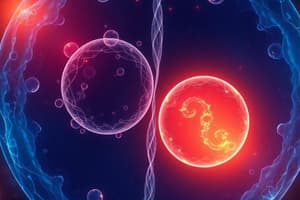Podcast
Questions and Answers
Which process involves the formation of four daughter cells?
Which process involves the formation of four daughter cells?
- Meiosis (correct)
- Mitosis
- Karyokinesis
- Cytokinesis
Which process contributes to genetic diversity by allowing crossing over to occur?
Which process contributes to genetic diversity by allowing crossing over to occur?
- Meiosis (correct)
- Cytokinesis
- Mitosis
- Karyokinesis
In which process do daughter cells have the same genetic information as the parent cell?
In which process do daughter cells have the same genetic information as the parent cell?
- Cytokinesis
- Mitosis (correct)
- Meiosis
- Karyokinesis
Which process occurs in body cells for growth and maintenance purposes?
Which process occurs in body cells for growth and maintenance purposes?
How many rounds of cell division occur during meiosis?
How many rounds of cell division occur during meiosis?
During prophase, how do chromosomes behave differently in mitosis compared to meiosis I?
During prophase, how do chromosomes behave differently in mitosis compared to meiosis I?
What occurs during anaphase in mitosis as opposed to meiosis I?
What occurs during anaphase in mitosis as opposed to meiosis I?
What distinguishes telophase outcomes between mitosis and meiosis I?
What distinguishes telophase outcomes between mitosis and meiosis I?
How does Meiosis II differ from Meiosis I and resemble mitosis?
How does Meiosis II differ from Meiosis I and resemble mitosis?
Why is the differentiation between Meiosis II and Mitosis important for genetic diversity?
Why is the differentiation between Meiosis II and Mitosis important for genetic diversity?
What is a key difference between the division of cells in mitosis and meiosis?
What is a key difference between the division of cells in mitosis and meiosis?
Which process does not involve crossing over, leading to genetic recombination?
Which process does not involve crossing over, leading to genetic recombination?
What is a significant difference in the genetic content of daughter cells produced by mitosis compared to meiosis?
What is a significant difference in the genetic content of daughter cells produced by mitosis compared to meiosis?
Which key aspect of cell division contributes significantly to genetic diversity among produced gametes?
Which key aspect of cell division contributes significantly to genetic diversity among produced gametes?
Why is the chromosome number halved during meiosis but remains constant in mitosis?
Why is the chromosome number halved during meiosis but remains constant in mitosis?
Which statement accurately describes the role of mitosis and meiosis in the life cycle of organisms?
Which statement accurately describes the role of mitosis and meiosis in the life cycle of organisms?
Which stage of cell division is responsible for ensuring that daughter cells are genetically different from each other and from the parent cell?
Which stage of cell division is responsible for ensuring that daughter cells are genetically different from each other and from the parent cell?
What is the key difference in chromosome behavior during metaphase between mitosis and meiosis I?
What is the key difference in chromosome behavior during metaphase between mitosis and meiosis I?
How does anaphase in mitosis differ from anaphase in meiosis I?
How does anaphase in mitosis differ from anaphase in meiosis I?
What is the outcome of telophase in mitosis compared to meiosis I?
What is the outcome of telophase in mitosis compared to meiosis I?
Why does the second division in meiosis (Meiosis II) resemble mitosis for haploid cells?
Why does the second division in meiosis (Meiosis II) resemble mitosis for haploid cells?
What contributes significantly to biological diversity and reproduction by ensuring a mix of genetic material from both parents?
What contributes significantly to biological diversity and reproduction by ensuring a mix of genetic material from both parents?
Which statement accurately describes the outcome of Meiosis II?
Which statement accurately describes the outcome of Meiosis II?
In which phase do whole chromosomes split and move to opposite poles during cell division?
In which phase do whole chromosomes split and move to opposite poles during cell division?
What distinguishes the behavior of chromosomes during prophase in mitosis from prophase in meiosis I?
What distinguishes the behavior of chromosomes during prophase in mitosis from prophase in meiosis I?
What is a distinguishing feature of the chromosome behavior during anaphase in mitosis compared to anaphase I in meiosis?
What is a distinguishing feature of the chromosome behavior during anaphase in mitosis compared to anaphase I in meiosis?
What is a key similarity between karyokinesis in mitosis and meiosis?
What is a key similarity between karyokinesis in mitosis and meiosis?
What contributes to the genetic variation found among the formed gametes?
What contributes to the genetic variation found among the formed gametes?
How does the behavior of chromosomes during prophase differ in mitosis compared to prophase I of meiosis?
How does the behavior of chromosomes during prophase differ in mitosis compared to prophase I of meiosis?
What is a critical difference between the daughter cells produced by mitosis compared to those produced by meiosis?
What is a critical difference between the daughter cells produced by mitosis compared to those produced by meiosis?
Which statement accurately describes the role of cytokinesis in cell division?
Which statement accurately describes the role of cytokinesis in cell division?
During which phase of cell division does crossing over occur, contributing to genetic variability?
During which phase of cell division does crossing over occur, contributing to genetic variability?
What is a key difference in the behavior of chromosomes during telophase in mitosis and meiosis I?
What is a key difference in the behavior of chromosomes during telophase in mitosis and meiosis I?
What distinguishes the role of anaphase in mitosis from anaphase in meiosis I?
What distinguishes the role of anaphase in mitosis from anaphase in meiosis I?
Which statement best describes the outcome of metaphase for mitosis compared to meiosis I?
Which statement best describes the outcome of metaphase for mitosis compared to meiosis I?
What contributes significantly to biological diversity by ensuring offspring inherit a mix of genetic material from both parents?
What contributes significantly to biological diversity by ensuring offspring inherit a mix of genetic material from both parents?
How does the division of cells during prophase differ between mitosis and meiosis I?
How does the division of cells during prophase differ between mitosis and meiosis I?
During cell division, how do daughter cells produced by mitosis differ from those produced by meiosis I?
During cell division, how do daughter cells produced by mitosis differ from those produced by meiosis I?
What is a crucial aspect of the second division (Meiosis II) that ensures genetic variation among produced gametes?
What is a crucial aspect of the second division (Meiosis II) that ensures genetic variation among produced gametes?
What occurs during Metaphase that differentiates between mitosis and Meiosis I?
What occurs during Metaphase that differentiates between mitosis and Meiosis I?





